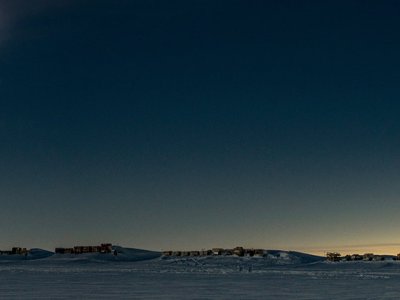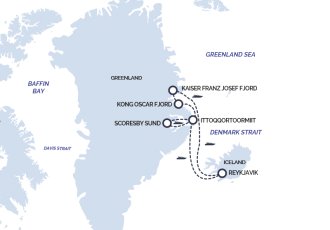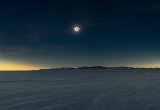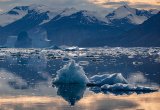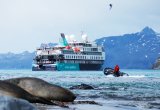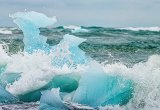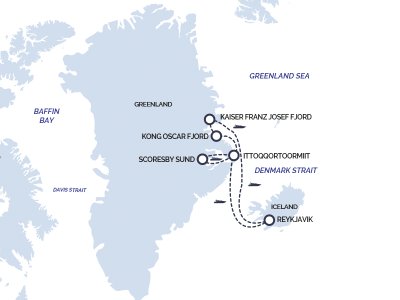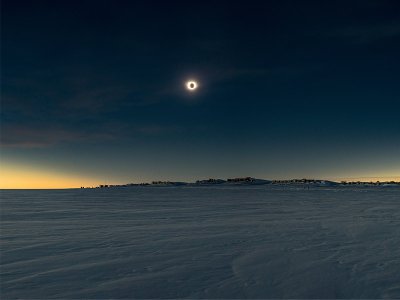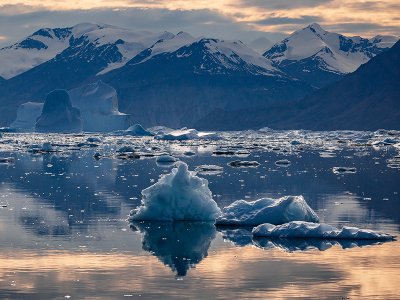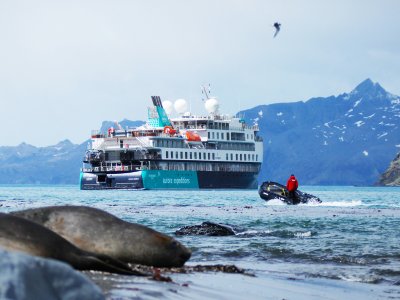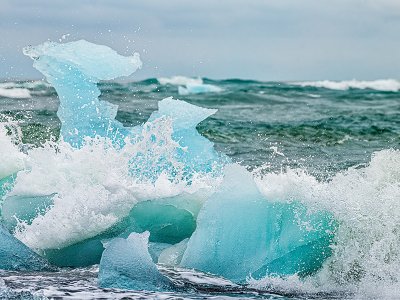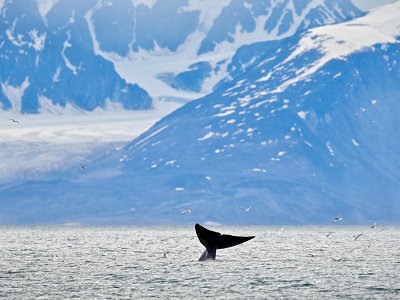GET IN TOUCH
Enquire About Polar Routes
BOOK AN APPOINTMENT
Please fill out your details below to book an appointment with a travel specialist:
CALL US
Mon to Sat: 9am-5:30pm
0203 196 1000
GET IN TOUCH
Enquire About Total Solar Eclipse Cruise: Iceland to Greenland with New Scientist
Total Solar Eclipse Cruise: Iceland to Greenland with New Scientist
Experience an awe-inspiring total solar eclipse in 2026, aboard a boutique polar expedition vessel while exploring the Scoresby Sund in Greenland, the longest fjord system in the world.
You will be accompanied throughout by guest speakers, including astronomer and eclipse expert Jamie Carter, who will guide you through the event with talks on solar photography, astronomy, future eclipses, and the all-important pre-eclipse briefing. While Greenland never becomes completely dark during August, Jamie can still introduce you to the sky’s celestial wonders.
You will be accompanied by and hear talks from the highly knowledgeable and supportive expedition team, who will give a full programme of talks, shore visits, and Zodiac boat safaris covering topics including glaciology, botany, marine biology, wildlife, and the history of polar exploration, deepening your connection to this remote and rugged coastline.
This unique cruise will be hosted aboard a new, state-of-the-art polar expedition vessel, the Sylvia Earle, one of a handful of passenger ships to feature the revolutionary Ulstein X-BOW, reducing fuel consumption and allowing a sleeker cruising experience.
Plus before embarking you will explore Iceland's Golden Circle. Experiencing the elemental power of island at Þingvellir National Park and the Geyser geothermal area.
You will travel with like-minded people who love to connect with the natural world and experience the wonder of eclipses and astronomy. The tour will provide a fun and relaxing environment for curious-minded couples, friends and solo travellers. The talks will be suitable for those who are new to solar astronomy as well as experienced eclipse chasers.
Onboard Expert
Jamie Carter is an award-winning journalist writing about the night sky and eclipses. He is the recipient of the 2023 Popular Media Award from the American Astronomical Society's Solar Physics Division, and is the world's foremost solar eclipse journalist, an experienced science, travel and photography journalist, and a stargazer writing about exploring the night sky, moon-gazing, astro-tourism, astronomy and space exploration.
Jamie is the editor of WhenIsTheNextEclipse.com and SmartTelescopeReviews.com, and author of When Is The Next Eclipse? A traveler’s guide to total solar eclipses 2024-2034 and A Stargazing Program for Beginners: A Pocket Field Guide. He also writes for publications and websites including Space.com, Live Science, Sky & Telescope magazine, BBC Sky At Night magazine, The Planetary Society, New Scientist, Travel+Leisure, T3, the South China Morning Post and Digital Camera World.
Life on board
Your expedition is a carefully curated mix of daytime activity offboard, designed to immerse you in your polar surroundings, and talks while on board. During the day, the itinerary remains flexible, as the captain and expedition leader will look at prevailing conditions and sightings, to give you the best opportunity to enjoy scenery and for wildlife encounters.
The expedition team will help you experience a range of activities centred around daytime exploration via Zodiac boat safaris (investigating coves, glaciers and wildlife), guided hikes (exploring pristine beaches and stunning wilderness) and photography (helping you improve your skills with a camera). They will aim to deliver two shore excursions every day while in the fjords.
In the evening and during periods when the ship is sailing, Jamie Carter, guest speakers and the expedition crew will give informative lectures and practical workshops on board.
You will have the opportunity to participate in the unique citizen science programme run by AE Expeditions. It is designed to be a hands-on, immersive and transformative experience that will help you protect the beauty of our planet. Various sampling and data collection projects will be conducted on your voyage and a citizen science coordinator will be on hand to introduce and assist you.
Your expedition can be as active or as leisurely as you want, and no activity or talk is mandatory.
Highlights
- Experience a total solar eclipse while surrounded by a stunning Arctic landscape.
- Accompanied throughout and with talks by astronomer and eclipse expert Jamie Carter.
- Cruise along blue glacier fronts and through stunning fjords on the Sylvia Earle, an intimate, purpose-built polar expedition ship.
- Discover the thrill of seeing species on land, sea and air, including whales, seals and foxes.
- Enjoy short tundra hikes amid the beautiful scenery of the fjord system.
- Daily Zodiac boat safaris exploring fjords and glaciers.
- Explore Iceland’s Golden Triangle, including the Þingvellir National Park and the Geyser geothermal area.
Price Includes
- Eleven nights aboard the Sylvia Earle polar expedition vessel.
- One night in a hotel in Reykjavik on bed and breakfast basis.
- Full board throughout the cruise, including snacks, tea and coffee, plus beer, house wine and soft drinks at dinner.
- Captain's welcome and farewell receptions on board.
- Talks from Jamie Carter and New Scientist guest speaker.
- Talks and guided activities from the onboard expedition team.
- All Zodiac cruising and landing activities led by the expedition team.
- Arrival/departure group airport transfers for those arriving on the 7th and departing on the 19th.
- Free limited Wi-Fi onboard.
- 3-in-1 AE Expeditions polar jacket.
- Complimentary use of muck boots during the voyage.
- Photo log of the expedition by the onboard photographer.
- Daily cabin service.
- Port surcharges, permits and landing fees.
- 24-hour support.
Itinerary
Day 1 - Arrive In Reykjavik
After arriving at Keflavik airport, you will be transferred to a central hotel in the capital Reykjavik, to check in for your first night. Here you will be welcomed by the New Scientist and AE Expeditions teams, who will run through the embarkation procedures and give an introductory lecture on the science of Iceland. The rest of the day is yours to explore Reykjavik.
Day 2 - Explore Iceland’s Golden Circle Then Board The Sylvia Earle
Day 3 - At Sea And Talks Commence
Days 4 And 5 - Explore Ittoqqortoormiit And Scoresby Sund
Day 6 - Total Solar Eclipse Day
Days 7 To 11 - Further Exploration Of Scoresby Sund Then On To Kong Oscar And Kaiser Franz Josef Fjords
Day 12 - At Sea Across The Denmark Strait
Day 13: Disembark At Reyjavik, Fly Home Or Explore Iceland Further
Departures and Prices
Send An Enquiry
Enquire About Total Solar Eclipse Cruise: Iceland to Greenland with New Scientist
When Do You Want To Go?

From your first booking with us, you’ll become a member of My Routes Rewards and begin collecting points for every holiday you book!
ABOUT US
We'll compare a huge selection of expedition ships, cruises and operators to find your perfect cruise.
Our prices are amongst the best you'll find, plus look out for Polar Routes exclusive offers!
As supporters of the UK Antarctic Heritage Trust, booking with us helps support the work of the trust within Antarctica.
All our holidays are ATOL protected (11104), for your complete peace of mind.


Why book with Polar Routes?
CHOICE
- We can compare a huge selection of expedition ships, cruises and operators.
- From former Russian research vessels to larger and luxurious ships - there is an expedition cruise to suit you.
- Our Polar Specialists will help you choose the perfect expedition cruise for your requirements.
SPECIALISTS
- We are the expedition cruise specialists and know all the polar destinations inside out.
- Our expert team of Polar Specialists have extensive knowledge of all the expedition ships & operators.
- All of our Polar Specialists have first-hand experience of expedition cruising to the polar regions.
VALUE
- Our prices are amongst the best you'll find, plus look out for Polar Routes exclusive offers!
- All our holidays are ATOL protected (11104), for your complete peace of mind.
- As supporters of the UK Antarctic Heritage Trust, booking with us helps support the work of the trust within Antarctica.


